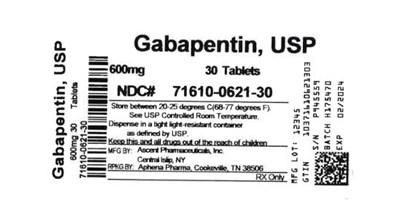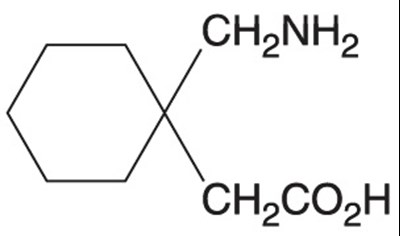Product Images Gabapentin
View Photos of Packaging, Labels & Appearance
- Bottle Label 600 mg - 71610 0621 30
- Aphena Pharma Solutions - TN - Aphena
- sideeffects - Sideeffects
- Table-1 - Table1
- Table-2 - Table2
- Table-3 - Table3
- Table-4 - Table4
- Table-5 - Table5
- Table-6 - Table6
- clcr - clcr
- Figure-1 - figure1
- Figure-2 - figure2
- Figure-3 - figure3
- Figure-4 - figure4
- struc - struct
Product Label Images
The following 15 images provide visual information about the product associated with Gabapentin NDC 71610-621 by Aphena Pharma Solutions - Tennessee, Llc, such as packaging, labeling, and the appearance of the drug itself. This resource could be helpful for medical professionals, pharmacists, and patients seeking to verify medication information and ensure they have the correct product.
sideeffects - Sideeffects

This text describes several symptoms that may be related to a health condition. These symptoms include lack of coordination, viral infection, difficulty with speaking, tremor, swelling (typically in the legs and feet), feeling tired, fever, feeling drowsy, nausea and vomiting, jerky movements, double vision, and unusual eye movement. The cause of these symptoms is not specified, but they may be indicative of a neurological or viral condition. Further evaluation by a medical professional is recommended.*
Table-1 - Table1

This is a table showing the dosage of gabapentin based on renal function. It provides the total daily dose of gabapentin for different ranges of creatinine clearance (measured in mL/min), as well as the dose regimen (e.g. 300TID means 300mg three times daily). The table also provides a supplemental post-hemodialysis dose for patients on hemodialysis. The table contains abbreviations including TID (three times a day), BID (two times a day), and QD (single daily dose). For patients with creatinine clearance <15 mL/min, the daily dose should be reduced proportionally.*
Table-3 - Table3

This is a table presenting adverse reactions reported in patients with postherpetic neuralgia who were given gabapentin versus placebo. Adverse reactions are listed and presented as a percentage of patients who experienced them. The adverse reactions are presented by body system, including body as a whole, digestive system, metabolic and nut, nervous system, respiratory system, and special senses. Some common adverse reactions reported included dizziness, somnolence, diarrhea, dry mouth, and blurred vision.*
Table-4 - Table4

This is a table that shows the adverse reactions in pooled placebo-controlled add-on trials in epilepsy patients of age >12 years who were administered Gabapentin® and Placebo. The table provides the number of patients (N) for Gabapentin® and Placebo and the percentage (%) of patients who reported adverse reactions. The adverse reactions are grouped into categories such as Body As A Whole, Cardiovascular, Digestive System, Nervous System, Respiratory System, etc. Some examples of adverse reactions reported by over 10% of patients taking Gabapentin® are fatigue, somnolence, and dizziness. Amblyopia, which is often described as blurred vision, was reported by 4% of patients taking Gabapentin®. It should be noted that the patients were also on background antiepileptic drug therapy.*
Table-5 - Table5

This appears to be a table displaying adverse reactions in a placebo-controlled trial for the drug Gabapentin in pediatric patients (ages 3 to 12 years) with epilepsy. The table compares the incidence of adverse reactions between Gabapentin and Placebo groups. However, the text is incomplete, making it difficult to interpret the results accurately.*
Table-6 - Table6

This is a table providing information on controlled PHN studies. The table includes the study name, duration, dosages, and the number of patients receiving Gabapentin and placebo. Study 1 lasted 8 weeks with a target dosage of 3600 mg/day and had 113 patients receiving Gabapentin and 116 receiving placebo. Study 2 lasted 7 weeks with target dosages of 1800 and 2400 mg/day given in 3 divided doses and had 223 patients receiving Gabapentin and 111 receiving placebo. The table includes a total of 336 patients receiving Gabapentin and 221 receiving placebo.*
clcr - clcr

This text is a formula to calculate creatinine clearance, a measure of the renal function in patients. The formula uses the patient's age, weight, and serum creatinine level to estimate the glomerular filtration rate (GFR), which indicates how well the kidneys are filtering waste from the blood. The formula is adjusted for female patients by multiplying their weight by 0.65.*
Figure-1 - figure1

The figure depicts the weekly mean pain scores observed in the intent-to-treat (ITT) population for Study 1. However, as the figure is not available, only the data and axis labels can be interpreted.*
Figure-3 - figure3

The provided text seems to be a part of a figure showing the percentage of responders in controlled studies of PHN with different medications. The figure has two studies (Study 1 and 2) and different medication dosages - PBO, GBP 1800, and GBP 2400. The y-axis indicates the percentage of responders with greater than 50% reduction in pain score at the endpoint. However, due to the limited text, it is not possible to provide further details about the study or its findings.*
* The product label images have been analyzed using a combination of traditional computing and machine learning techniques. It should be noted that the descriptions provided may not be entirely accurate as they are experimental in nature. Use the information in this page at your own discretion and risk.





